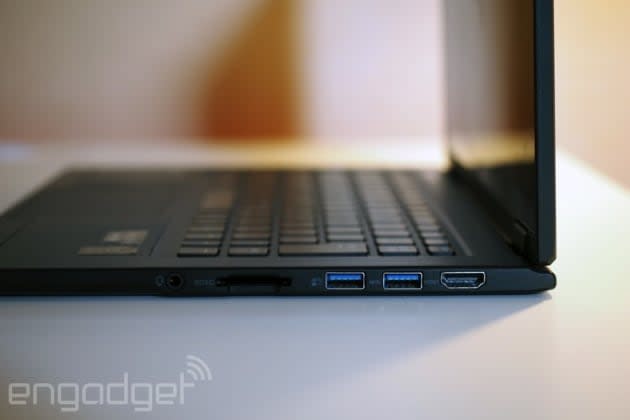4K, VR and a watch by Apple: What we're excited for in 2015

Now that we've emerged from the technological wonderland of CES unscathed, the rest of 2015 is coming into focus. It's going to be a year where the smart home, connected cars and the entire "Internet of Things" concept finally reaches everyday consumers. And, on the whole, it looks like we're going to see plenty of other long-anticipated products and technological concepts come to fruition. Barring any major surprises, it looks like 2015 is going to be a year of evolutionary progress, rather than a revolutionary one. But that doesn't mean we're not excited for what's to come.
The rise of 4K TVs
With 4K, what seemed like mere TV industry fluff years ago is actually getting interesting in 2015. Prices for 4K TV sets are quickly coming down (Vizio's 4K set is just $800 right now); the content is slowly trickling down from Netflix, Amazon and others; and, most importantly, it actually looks significantly better than your existing HDTV. Sure, 4K isn't a dramatic upgrade like the jump to HD from standard def, but it's still a noticeable one (especially when combined with OLED). I wouldn't rush out to replace my 1080p plasma and projector anytime soon, but if you've been holding out on upgrading, 4K is worth a look this year.

Enter the Apple Watch
Sure, this is going to be a big year for wearables in general, but the Apple Watch is the one the entire world will be watching. After plenty of ho-hum smartwatch attempts over the past year, everyone's waiting for Apple to redefine the market once again, just like it did with the iPhone and iPad in mobile.
Engadget Associate Editor Jon Fingas is particularly excited for it:
I dig Android Wear, but my big expectation for the year is the Apple Watch. It's designed to look good and has some clever interface concepts that haven't been tried before. And let's face it, there's something exciting and scary about Apple's first device in a category. Is it going to be brilliant? A buggy mess? It's hard to tell, but it'll be exciting ... and you can't say that about a lot of devices.

Thinner and lighter laptops
Now that Intel's Broadwell chips are out, we're looking forward to how laptop makers will use them to slim down their machines. One of the first computers to use that chip, Lenovo's LaVie HZ550 (which won our Best of CES award for laptops), weighs only 1.72 pounds and seems impossibly thin. It's hard to imagine a laptop getting even thinner than that without sacrificing too much battery life and computing power, but we're sure plenty are going to try.

VR advances
Virtual reality made some pretty significant progress last year, and we're eager to see where things go in 2015. Oculus might release its consumer VR headset this year (though there are significant challenges with that), Samsung already launched its (surprisingly polished) Gear VR, and we'll likely get a better sense of how Sony's Project Morpheus competes. We know the tech works; now VR outfits just need to make it more accurate, cheaper and easier to use.

The Internet of Things grows up
We've been hearing plenty of hype around the Internet of Things (IoT) for a while now, but this year we'll actually see plenty more smart devices you may want to buy. IoT basically describes connecting everything in our lives, from our homes to our cars. At CES, we saw things like Misfit's Bolt (above), a colorful, smart LED bulb that's cheaper than the competition, and several connected cars that could change the way we drive forever. Not everything needs to get online, to be sure, but the idea of the web touching things outside of our phones and computers is certainly intriguing.

Smarter and more fashionable wearables
Expect to see plenty of wearables this year focusing on two major trends: better sensor capabilities (things like body-composition sensing and persistent heart-rate monitoring), and better looks. Some devices, like Jawbone's Up3, are aiming for both. Others, like Misfit's wearable partnership with Swarovski, are all about the looks. Either way, they both show how much the wearable market has grown up.

USB Type-C cables
Yes, we're nerds. So when we hear there's an upcoming USB standard that's reversible, recharges devices faster and is also double the speed of USB 3.0, we're instantly on board. USB Type-C is eventually going to replace the micro-USB standard on smartphones and tablets. And as a bonus, it may also allow for even thinner mobile gadgets. While it just hit mass production, it'll likely find its way into many high-end devices this year. "Considering the device I plug a cord into and out of the most is my phone, I'm excited to see what phones will adopt this new technology," said Engadget's Engagement Editor and social media guru John Colucci.

Project Ara and modular smartphones
Perhaps it's just a desire for novelty, but we're intrigued by Google's modular smartphone concept, Project Ara. Ara might not be for everyone (indeed, Google's focusing on emerging markets first), but going modular could put an end to the disposable-gadget trend. If you could upgrade your phone as you needed, it might also last you much longer than the latest iPhone.
